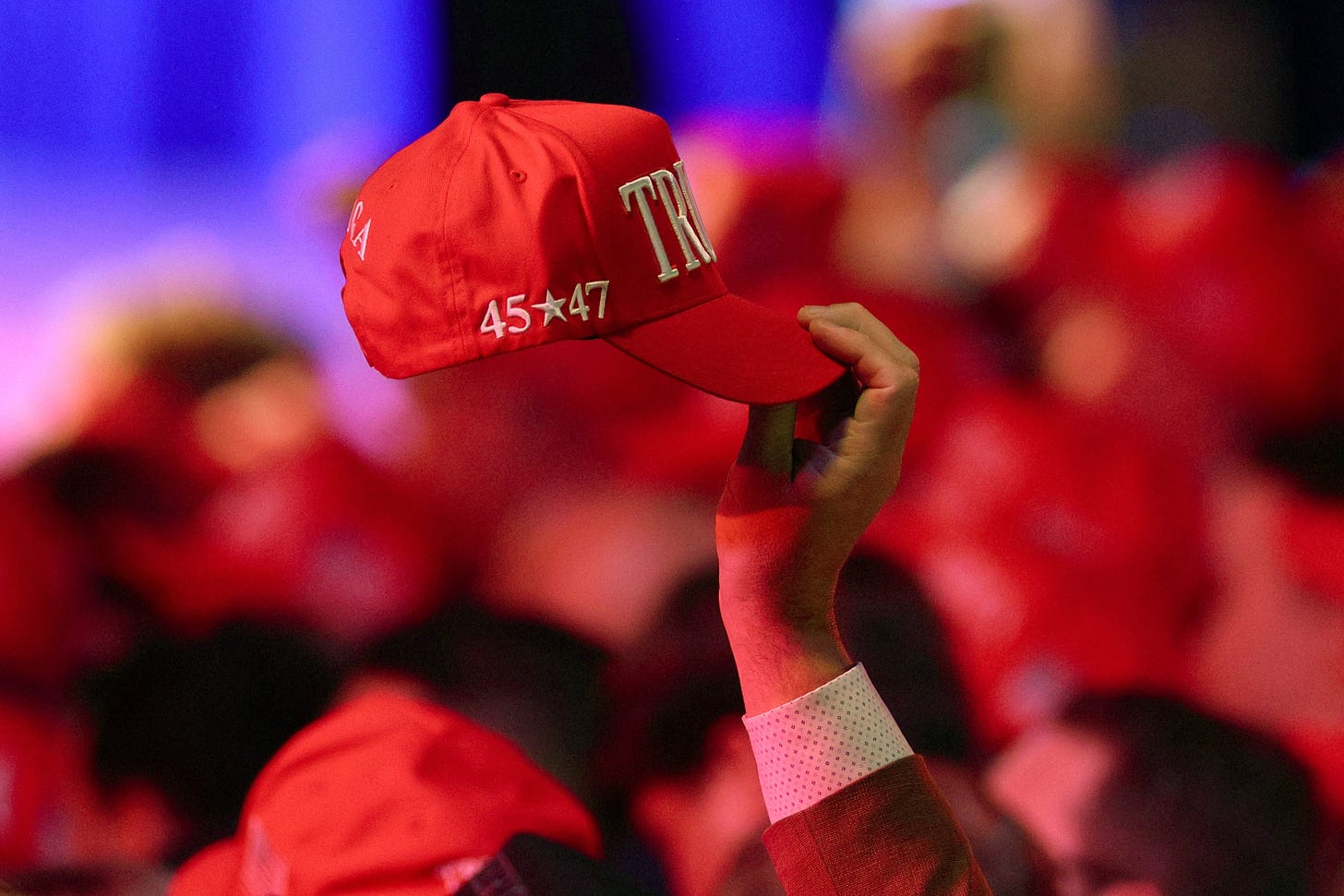It’s clear after this week that the landscape of American politics and power has shifted in fundamental ways. At Persuasion we aim to give you the best analysis of current events, including highly consequential elections. But we also strive to take a step back, to offer longform essays and meditations on a range of cultural and philosophical issues, animated by the principles of liberalism, pluralism, and free inquiry.
As we work to offer insights into the shift America just witnessed—and build a path forward grounded in robust liberalism—will you consider supporting Persuasion by becoming a paid subscriber? As a nonprofit publication we rely on reader support to pay our staff. So if you value what we do, and want to see us continue our work over the next four years, please consider becoming a paid subscriber today!
- Luke, senior editor
Donald Trump looks on track to win all seven swing states by comfortable margins. He will also win the popular vote for the first time, most likely with an outright majority. Vote counting will continue for days and even weeks in some places, but at the moment, Trump leads 50.9 to 47.6 percent.
According to preliminary exit poll data cited in the Financial Times, Trump has increased his vote share relative to four years ago with nearly every demographic group. Not just white non-college men and white non-college women (his base), but also: Hispanics, Asians, blacks, voters 18-29 years old, voters 30-44, voters 45-64, men in general, and women in general. He’s made gains across nearly the entirety of the country: in rural areas especially, but also in suburbs and cities; in red states, but also in blue states; in every state, in fact, except Washington.
As others have noted, Trump’s win in 2016 could be dismissed as a fluke or aberration caused by our highly idiosyncratic way of electing presidents via the state-based Electoral College. This enabled Democrats and anti-Trump Republicans to console themselves with the thought that he didn’t really win. His presidency was at bottom illegitimate. The American people didn’t sign up for this. The repudiation of him in 2020 therefore seemed foreordained. And after the horrors of January 6, 2021 and all the criminal indictments that followed, the idea that the voters would return him to the White House seemed unthinkable to many.
And yet here we are.
The outcome leaves us to make sense of what it means—and what it means, I think, is that Donald Trump has consolidated the fluke of 2016. The Republican Party has accomplished the realignment we’ve all sensed has been in the air over the last decade. Because the country is so ideologically polarized, the shift is still a relatively narrow one, within a few points of the 50-yard line. But it is very real.
The Shape of the Realignment
Trump will probably end up with the biggest Electoral College and popular vote win for a Republican since George H.W. Bush prevailed against Democrat Michael Dukakis in 1988, 36 years ago. And he will have done it by significantly expanding the GOP’s electoral coalition, making it precisely the kind of cross-racial working-class party Trump’s right-populist ideological defenders have been loudly prophesying for the past eight years.
Given that even this achievement amounts to a relatively small popular-vote advantage over Democrat Kamala Harris, how big is it, really? I’d say it’s pretty enormous.
Trump didn’t just activate even more disengaged, low-information voters. He increased his margins in rural areas, which were already solidly Republican. But he also built his win on gains with key Democratic groups: Hispanics, Asians, blacks. That makes the GOP more diverse and the Democratic Party less so. As Ruy Teixeira of The Liberal Patriot put it in a justifiably angry post-election column looking at gender, age, and other demographic categories, Trump managed to shatter the Democrats’ electoral coalition.
Can the Democrats win those voters back in future elections? Of course. I know a lot of Democrats who are sure they will do so, since the second Trump administration is likely to be every bit as much of a shitshow as the first one, and quite possibly far more so. If such thoughts help Democrats to console themselves after a painful defeat, then they should indulge them for the moment, with votes still being counted.
But before long, it will be important that they remember we’ve been through this before. Trump was already president. Everyone who voted in this election lived through Trump 1.0. They saw January 6 with their own eyes. They heard his campaign over the past year. And yet, despite (or perhaps, for some, because of) it all, more people than ever were persuaded to give Trump another try.
Could he screw it all up and end his presidency deeply unpopular? I’d say that’s actually the likeliest scenario. But just as Trump’s loss in 2020 didn’t preclude a bigger win than ever four years later, so a chaotic, polarizing, and destructive presidency over the next four years won’t come close to guaranteeing the reversal of the right-populist realignment he has achieved. And by then it won’t matter: Trump will likely have already implemented—or at least tried to implement—the most destructive and dangerous elements of his agenda (see my rundown on that here and here.)
I think it’s likely that Trump has now proven himself to be easily the most consequential figure in American political history since Reagan. He’s won a decisive second term. He will have a solidly Republican majority in the Senate. He’s on track to enjoy a narrow majority in the House. The Supreme Court has a 6-3 conservative majority. For the foreseeable future, Democrats will be trying to win back and wield power while being forced to play within the right-populist lines Trump has drawn.
The Way Forward for the Opposition
In concrete terms, this suggests several things.
For one, Harris’ quite reasonable attempt to win by luring Trump-hating Nikki Haley supporters from the GOP to the Democratic Party with warm endorsements from Liz Cheney and other Republicans was a dead end. Even if some of those people made such a cross-partisan pilgrimage, they were vastly outnumbered by others who either moved over to Trump or just neglected to vote.
Which means Reaganism is now well and truly dead, with no substantial base in either party.
Then there’s the topic I just wrote about for The New York Times: the deep and widespread collapse of trust and confidence in government and public institutions more generally over the past two decades that I think has contributed in decisive ways to fueling the right’s politics of anger, grievance, and cynicism. Given that baseline, Democrats would be well advised to portray themselves as the party of responsible reformers eager to make government more responsive to public opinion, more humble and willing to admit mistakes, and more eager to learn from those errors. Democrats need to help restore trust and confidence in government before seeking to expand its reach.
Finally, Democrats need to leave behind a lot of childish assumptions that emerged in the wake of the shocking and seemingly inexplicable 2016 Trump win, and in some cases have deepened and intensified in the years since. This includes blaming the outcome on pervasive white supremacist ideology, collusion between the Republican campaign and Russian intelligence services, and other even-more-fanciful conspiracies. The results this time weren’t, to put it in poker terms, a rare inside straight easily manipulable by nefarious forces. Trump gained ground in nearly every corner of the country, among nearly every segment of the electorate.
Which means Trump has real and broad-based support. Does some of that support come from fervent racists and xenophobes and sexists? I’m sure it does. Just as undoubtedly the outright fascists and neo-Nazis are thrilled by his win. But there are many more Americans who voted for him for other reasons.
It is a fallacy to believe that the thing you see in and hate about a politician is inevitably reflected in those who vote for him or her. That’s why I was so critical of Harris for closing her campaign by pushing the line that Trump is a fascist—because it implied that those entertaining a vote for him were fascists themselves. Some small number of people might have responded to that by thinking, “why yes, I am, and thanks for noticing.” But far more probably found the suggestion outrageous, condescending, and insulting.
It’s time for the political and intellectual opposition to Trumpism to move forward—soberly, intelligently, with a level head, and in full awareness of just how big Donald Trump’s achievement really is.
Damon Linker writes the Substack newsletter “Notes from the Middleground.” He is a senior lecturer in the Department of Political Science at the University of Pennsylvania and a senior fellow in the Open Society Project at the Niskanen Center.
A version of this piece also appears today in Notes from the Middleground.
Follow Persuasion on Twitter, LinkedIn, and YouTube to keep up with our latest articles, podcasts, and events, as well as updates from excellent writers across our network.
And, to receive pieces like this in your inbox and support our work, subscribe below:






"Given that baseline, Democrats would be well advised to portray themselves as the party of responsible reformers eager to make government more responsive to public opinion, more humble and willing to admit mistakes, and more eager to learn from those errors. Democrats need to help restore trust and confidence in government before seeking to expand its reach."
I cannot reinforce this more strongly.
If so many Latinos (and to a lesser extent Blacks) felt comfortable voting for a racist if they agree with him about other things, if they don't feel like that's going to endanger them, that seems pretty good evidence that racism doesn't have the sort of power it had even a generation or two ago. Why Can't Liberalism Take a Win, part one million.